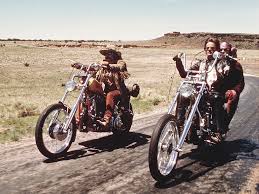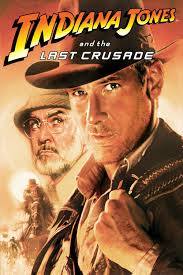Midway through the 60’s, the Hollywood industry seemed to be doing very well, with the release of blockbusters such as The Sound of Music in 1965 and Dr. Zhivago on the same year, generating huge profits. However, problems soon arose. Expensive studio projects failed miserably, TV networks stopped bidding for pictures and American movie attendance flattened out causing Hollywood companies to lose over $200 million annually by the year 1969.
 The producers had to fight back to stop the fast declining industry. One strategy was to produce a counter culture-flavored film aimed at young people. The most popular and influential films they produced were Dennis Hopper’s low-budget Easy Rider (1969) and Robert Altman’s M*A*S*H* (1970). However, other “youthpix” about campus revolution and unorthodox lifestyles proved disappointing at the box office.
The producers had to fight back to stop the fast declining industry. One strategy was to produce a counter culture-flavored film aimed at young people. The most popular and influential films they produced were Dennis Hopper’s low-budget Easy Rider (1969) and Robert Altman’s M*A*S*H* (1970). However, other “youthpix” about campus revolution and unorthodox lifestyles proved disappointing at the box office.
What helped the industry’s fortunes were films aimed squarely at broader audience such as Ford Coppola’s The Godfather (1972), Steven Spielberg’s Jaws (1975), George Lucas’s American Graffiti
(1913), Star Wars (1977), Brian De Palma Obsession, (1976) and Martin Scorsese (Taxi Driver, 1976 and Raging Bull, 1980). These directors came to be known as the movie brats. Instead of coming up through the ranks of the studio system, most had gone to film schools. They had not only mastered the mechanic of production but also learned about film aesthetics and history.
Unlike Hollywood directors from earlier times, the movie brats had encyclopedic knowledge of great movies and directors and produced some personal, highly self-conscious films as had been the case with the French New Wave. The movie brats worked in traditional genres but they do tried to give them autobiographical coloring by incorporating reflections from their childhood lives and even obsessions.
 Since movies had been a major part of the young directors’ lives, many films of the New Hollywood were based on the old Hollywood. At the same time, many directors admired the European tradition just like Robert Altman and Woody Allen, who in quite different ways, displayed creative attitudes fed by European cinema. Altman and Allen were of a slightly older generation, but many movie brats proved to be the most continuously successful directors of the era.
Since movies had been a major part of the young directors’ lives, many films of the New Hollywood were based on the old Hollywood. At the same time, many directors admired the European tradition just like Robert Altman and Woody Allen, who in quite different ways, displayed creative attitudes fed by European cinema. Altman and Allen were of a slightly older generation, but many movie brats proved to be the most continuously successful directors of the era.
 Lucas and Spielberg became powerful producers, working together on the Indiana Jones series and personifying Hollywood’s new generation. Coppola failed to sustain his own studio, but he remained an important director. Scorsese’s reputation rose steadily, and by the end of the 1980s, he was the most critically acclaimed living American filmmaker. During the 1980s, fresh talents won recognition, creating a New Hollywood. Many of the biggest hits of the decade continued to come from Lucas and Spielberg, but other, somewhat younger directors were successful: James Cameron, Tim Burton and Robert Zemeckis.
Lucas and Spielberg became powerful producers, working together on the Indiana Jones series and personifying Hollywood’s new generation. Coppola failed to sustain his own studio, but he remained an important director. Scorsese’s reputation rose steadily, and by the end of the 1980s, he was the most critically acclaimed living American filmmaker. During the 1980s, fresh talents won recognition, creating a New Hollywood. Many of the biggest hits of the decade continued to come from Lucas and Spielberg, but other, somewhat younger directors were successful: James Cameron, Tim Burton and Robert Zemeckis.
The resurgence of mainstream film was also fed by filmmakers from outside Hollywood. During the 1980s and 1990s, more women filmmakers also became commercially successful. Several directors from independent film managed to shift into the mainstream, making medium-budget pictures with widely known stars. The New Hollywood also absorbed some minority directors from independent film. Still other directors remained independent and more or less marginal to the studios.
Stylistically, no single coherent film movement emerged during the 1970s and 1980s. The most mainstream of the young directors continued the tradition of classical American cinema. Continuity editing remained the norm, with clear signals for time shifts and new plot developments. Some directors embellished Hollywood’s traditional storytelling strategies with new or revived visual techniques. Less well funded Hollywood film making cultivated more flamboyant styles. Several of the newer entrants into Hollywood enriched mainstream conventions of genre, narrative, and style.
While in the 1980s and 1990s younger studio directors adapted classical conventions to modern tastes, an energetic independent film tradition began pushing the envelope. By the end of the 1990s, the two trends were merging in surprising ways. As independent films began to win larger audiences, major studios eagerly acquired distribution companies such as Miramax and October Films. Much media journalism fostered the impression that Hollywood was being destroyed by independent filmmaking, but in fact, more and more, the major studios controlled audiences’ access to formerly independent productions.
At the start of the new century, many of the most thrilling Hollywood films were being created by a stronger new generation, born in the 1960s and 1970s and brought up on videotape, video games, and the Internet. Like their predecessors, these directors were reshaping the formal and stylistic conventions of the classical cinema while also making their innovations accessible to a broad audience.
(Notes from the book Film Art by Bordwell and Thompson)

